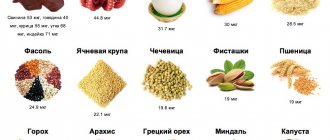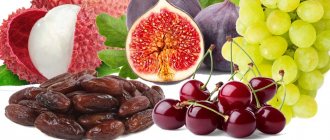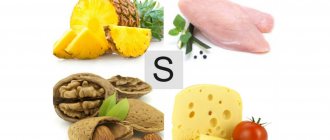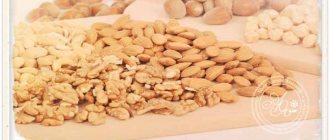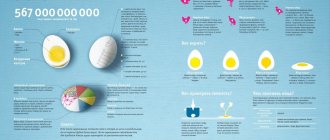Foods rich in selenium
It is somewhat incorrect to talk about foods that are rich in selenium, because food contains the mineral in tiny doses. However, selenium can be found in small dosages in many foods.
Selenium is present in sea and rock salt, as well as in seafood: squid, shrimp, fish, etc. It is also found in meat, offal, milk, and eggs.
Among plant products, it is most abundant in cereals, bran, corn, garlic, and mushrooms. It is also found in yeast.
What foods contain selenium?
Selenium, like any other mineral or vitamin, is best obtained from food.
Products that provide selenium into the body are quite diverse. Among them:
- Brazil nuts.
Literally 6-8 nuts contain about 540 mcg of selenium. But this indicator is quite arbitrary, since one study showed that the concentration of the mineral varies widely depending on the region in which they grew. In general, it is enough to consume them only 1-2 times a week to saturate the body with enough selenium. - Fish and seafood.
Total 48 gr. sardines contain 46% of the daily value of selenium, 85 g. tuna – 167%, 160 gr. halibut – 171%, 85 gr. oysters – 238%. Shrimp, salmon and crab contain 40 to 65 mcg. - Meat and poultry.
Less than 100 gr. ham contains 42 mcg of selenium, pork and beef - about 33 mcg, chicken - from 22 to 25 mcg, turkey - 31 mcg. - Dairy products.
One cup of cottage cheese contains about 20 mcg of selenium; the same container of milk and yogurt will provide the body with 8 mcg. - Eggs.
Two large eggs provide 56% of the daily value of the mineral. - Brown rice
. One cup of cooked long-grain brown rice provides 19 mcg of selenium, or 27% of the recommended daily value. - Mushrooms
. Total 100 gr. mushrooms contain about 12 mcg. - Chia seeds
. In 100 gr. The product contains 53 micrograms of selenium. - White bread.
One slice contains 10 mcg. - Seeds.
They are rich in vitamins and minerals, including selenium. One handful contains 27% of the daily value. In addition, sunflower seeds are an excellent source of dietary fiber and vegetable protein.
Do not forget that during heat treatment the content of this microelement in seafood decreases. The greatest benefit will come, for example, from freshly caught tuna tartare. Be sure to keep raw fish and seafood fresh.
Where else is selenium found? It can also be found in wheat bran, wheat and corn.
Biological role of selenium
Selenium functions:
- It is one of the minerals with an antioxidant effect, “working” in the body together with vitamin E. They prevent the formation of free radicals in the body, which has a healing and rejuvenating effect
- Improves the production of thyroid hormones, and therefore promotes the manifestation of their effects: improved metabolism, weight loss, improved skin condition, rejuvenation, etc.
- Protects the heart and blood vessels, slows down the development of atherosclerosis
- Participates in the regulation of cell division and renewal
- Improves the condition of the pancreas
- Contains many enzymes and hormonal substances
- Participates in ensuring visual acuity
- Protects the body from heavy metal salts, helps it get rid of toxins
- Increases the effectiveness of vitamin C on the body
- Strengthens immunity
- Accelerates tissue recovery after damage to various diseases and injuries
- Has an anti-cancer effect!
Benefits of selenium
Selenium's rise from an irrelevant mineral to an essential trace element has come as a result of research demonstrating its role in:
· regulation of metabolism;
· cell production;
· strengthening reproductive efforts;
· neutralize damaging free radicals;
· protecting the body from infection.
Besides these benefits, selenium is the only micronutrient that is included in our genetic material. Selenocysteine is a specific amino acid that is incorporated into numerous proteins in our bodies under the direction of the genetic code.
We primarily obtain selenium from plants and selenium bonds with proteins in the body to create compounds known as selenoproteins. There are at least 25 unique selenoproteins in our bodies that play important roles in many processes, protecting us from free radical damage by activating the release of thyroid hormone.
Signs of selenium deficiency
If the selenium content in the body is insufficient, a person experiences weakness, muscle pain, a tendency to cardiovascular diseases, and the condition of the pancreas and thyroid gland worsens.
There is an increased incidence of illness due to weakened immunity. With a lack of selenium, the effectiveness of vitamin E entering the body decreases. This causes disruption of a number of physiological processes, accelerated aging, hormonal disorders, and infertility.
Excess selenium
The toxic dose for the body that causes poisoning is 5 milligrams of the mineral per day.
The most dangerous to human health are selenic acid, selenic acid and hydrogen selenide.
Causes of microelement overdose.
- Selenium metabolism disorder.
- During professional activities. Excess of the compound in the body is observed in workers in the glass, oil refining, foundry, electronics, paint and varnish, copper smelting industries. In addition, people involved in the production of selenium sulfide, sodium selenite (pharmaceuticals), and pesticides (chemical industry) are at risk.
- Increased mineral content in the soil (USA, Australia, China).
- The supply of selenium with plants - concentrators (Happlopappus, astragalus, Stanlea).
It is almost impossible to obtain an overdose of a microelement from food, only in the case of uncontrolled consumption of Brazil nuts.
Symptoms of excess selenium in the body:
- convulsions;
- weakness;
- gastroenterocolitis;
- headache;
- severe cough, feeling of tightness in the chest;
- nausea and vomiting;
- garlicky skin odor;
- pain in the eyes;
- diarrhea;
- loss of appetite;
- hair loss, tooth sensitivity, brittle nails;
- peeling of the skin;
- constant fatigue;
- hysterical state.
Consequences of an overdose of the compound:
- blockade of sulfhydryl groups, which leads to enzyme inactivation;
- protein metabolism disorder;
- decreased blood pressure;
- disruptions in the functioning of the nervous system;
- increased permeability of capillary walls;
- development of atony, anemia, arthritis, bronchopneumonia, liver damage.
In severe cases, death is possible.
Best materials of the month
- Coronaviruses: SARS-CoV-2 (COVID-19)
- Antibiotics for the prevention and treatment of COVID-19: how effective are they?
- The most common "office" diseases
- Does vodka kill coronavirus?
- How to stay alive on our roads?
Remember, an excess of selenium can accelerate the growth of malignant tumors, so you should carefully monitor the amount of compound consumed per day.
Poisoning with this mineral is treated by administering sodium thiosulfate, glucose and a diet that involves strictly limiting the diet. The following are allowed: simple carbohydrates, rice, oatmeal, casein (milk protein).
The most important
Selenium is a powerful antioxidant that stimulates the thyroid gland, improves immunity and human reproductive functions.
In large doses, selenium is toxic, but the amount of this microelement necessary for health can be obtained from seafood, meat, unrefined grains and even mushrooms. Illustration: Muy Yum Tags:
- Antioxidants
- Pregnancy
- Avitaminosis
- Meat
- Thyroid
- Seafood
- Immunity
- Reproductive system
- Dictionary
To leave a comment you must be an authorized user
Selenium
Selenium is a biologically active microelement that is part of a number of hormones and enzymes and is thus associated with all organs and systems, along with other microelements, it is necessary to maintain the normal functioning of the body. The peculiarity of the electrophysical properties of selenium is noted by nature, which assigned to it some of the functions of genetic inheritance. Reproduction of generations, development, aging - selenium is actively involved in each of these processes.
Due to the uneven distribution of the element in different regions of the globe, diseases associated with its deficiency are being identified in a number of countries, including Russia. Selenium deficiency can cause diseases of various organs and systems, usually occurring against the background of low acidity. This causes premature aging and reduced life expectancy in humans and animals.
The role of selenium as an antioxidant.
This kind of reaction is especially surprising given selenium's impressive track record. The remarkable results of the oncology study simply confirm what we already know: this micronutrient is a powerful immunostimulant and carcinostatic agent with a wide range of effects on our health. There is no other mineral that is so vital to our antioxidant defense mechanisms. When we don't have selenium, we don't have glutathione peroxidase, a powerful antioxidant enzyme. Its absence leaves a huge gap in our defenses against oxidation-related diseases, including atherosclerosis, cardiovascular disease, rheumatoid arthritis and cataracts.
In addition, this trace element strengthens the body's immune defense against viruses and other pathogenic aggressors, and laboratory experiments show noticeable changes in such elements of the immune system as white blood cells, natural killer cells, antibodies, macrophages and interferon. Some studies suggest that regular preventive selenium supplementation may prevent hepatitis, herpes, and even Ebola virus infections.
Selenium supplements help with the following ailments:
AIDS. It is possible that selenium supplements help keep the HIV virus latent, preventing it from developing into full-blown AIDS. Selenium deficiency is very common in people infected with HIV, and the lower the level than normal, the more damage HIV can cause to a body with a weakened immune system. In fact, one theory of the development of AIDS suggests that HIV depletes the selenium content of an infected cell until it falls below a critical level. Then the cell bursts and the virus reproduces.
Maintaining optimal selenium levels not only replaces this loss and strengthens the immune system. Essentially, the mineral works much like several drugs proposed to treat AIDS—it inhibits a substance associated with the virus called reverse transcriptase. Based on all these considerations, Gerhard Schrauser, one of the most knowledgeable and renowned experts on selenium, argues that this mineral may be the single most important dietary supplement for people infected with the deadly virus. Because the full immune-boosting effects of a standard supplement program may not be seen for up to six months, Schrouser suggests that doctors can achieve a faster response by prescribing a very short initial course with daily doses of up to 8,000 mcg (8 mg).
Viruses require selenium to grow and replicate, but a lack of the mineral makes them more virulent. Laboratory studies show that a range of viruses—including those that cause hepatitis B and the common cold—when deprived of selenium mutate into more dangerous forms. This is exactly what we don’t want.
Cancer winner? Any substance that boosts the immune system and prevents oxidation can be expected to protect us in the war against cancer. Selenium's association with cancer prevention is well documented. Therefore, a study showing a 50% reduction in cancer mortality is not a bolt from the blue and should be taken with a grain of salt.
First, epidemiology allows us to predict the value of selenium. Population studies have firmly established that regions of the world with higher selenium levels in the soil have significantly lower rates of lung, colorectal, cervical and uterine cancer. Research in Finland has shown that male cancer patients have lower blood selenium levels than healthy controls, and selenium may be one of the most important nutrients for protection against these cancers. Cases of lymphoma, a type of cancer whose prevalence is rising sharply, are much more common among people with low levels of selenium in their blood.
The first data that heralded the success of selenium in the fight against cancer came from a study conducted in Lingjiang (China) among thirty thousand people. An impressive effect was obtained due to the fact that the subjects were given selenium 50 mcg per day for five years.
Perhaps the most successful cancer prevention study ever conducted was published on December 25, 1996. It took ten years and was supported by the National Cancer Research Institute; 1312 volunteers took part in the experiments (75% of them were men). During this time, subjects were given 200 mcg of selenium (from yeast) daily. Those who took selenium had a 49% reduction in mortality from the three most common types of cancer (lung, prostate and colorectal). The results of this study should change current thinking about cancer prevention and the use of nutritional supplements. They should certainly make us aware that for optimal protection against cancer we need more selenium than our diet can provide. Supplements provide excellent and inexpensive protection against this killer disease.
And it is also good for the heart. As an important antioxidant, selenium should be expected to play a role in the prevention of heart disease. In fact, people with low levels of selenium in their blood have been found to have a 70% higher risk of coronary heart disease compared to those with normal levels of the mineral; Danish researchers have proven that low plasma selenium concentrations are a significant risk factor for heart disease. Many population studies suggest that selenium is a protective nutrient against the development of heart and artery disease. Clinical observations have also shown that selenium is an important supplement for treating cardiac arrhythmias and preventing sudden cardiac death. Selenium protects the heart not only through its role in the production of glutathione peroxidase, which helps maintain antioxidant activity, but also by limiting toxic metals in the body such as cadmium, mercury and lead, which can damage heart tissue. Finally, selenium protects the heart from oxygen deprivation, from the toxic effects of drugs like Adriamycin, and from Keshan's disease.
Inflammatory diseases. Decreased selenium levels in the blood have been reported in patients with rheumatoid arthritis, and the anti-inflammatory properties of this mineral, especially when combined with vitamin E and other antioxidants, help relieve arthritis symptoms. Selenium also has a beneficial effect in osteoarthritis. However, the effect is not achieved immediately; It can take up to six months for the results of selenium supplementation to become noticeable.
Low levels of selenium have also been found in asthmatics. A study of people in New Zealand, where the soil is low in selenium, found that asthma was six times more common among people with low levels of the selenium-dependent enzyme glutathione peroxidase. Because glutathione peroxidase has anti-inflammatory properties, selenium is also useful in treating other inflammatory diseases, such as colitis and psoriasis. (The best results for treating psoriasis have been obtained by directly applying selenium to the affected skin).
Thyroid diseases. Selenium is important for thyroid function because it affects the enzyme that activates the main thyroid hormone (T4). In the absence of selenium, the effect of thyroid replacement therapy may be incomplete; This means that selenium deficiency can lead to a slow metabolism and even obesity. Selenium not only activates thyroid hormone - it protects the thyroid gland from the damaging effects of free radicals, which can lead to hypothyroidism. Selenium supplements appear to be especially important for older adults with thyroid disorders.
Metal poisoning. Selenium's greatest contribution to health comes from its ability to eliminate the threat posed by toxic metals such as lead, cadmium and mercury. It binds to metals, making them inert and harmless. An example is people working with mercury in the former Yugoslavia. Although they are exposed to large amounts of this metal, due to the local soil being rich in selenium, their diet contains enough of this mineral to protect them from poisoning. Another clinical benefit of selenium has recently been demonstrated: its ability to reduce the toxicity of platinum-containing chemotherapy drugs.
I discovered that the main cause of multiple sclerosis is the accumulation of toxic metals in the body. Multiple sclerosis is more common in regions where there is no selenium. In addition, those suffering from this disease are found to have low levels of glutathione, which is a sign of selenium deficiency.
Birth defects. In both men and women, fertility depends on optimal selenium intake. The same applies to the health of the newborn child. Along with folic acid and zinc, selenium is critical in preventing babies from being born with an underdeveloped spine as a result of neural tube defects. These infants, as well as their mothers, tend to have lower selenium levels than matched healthy individuals. Pregnant women who don't get enough selenium are more likely to have a miscarriage, and their babies may suffer from muscle weakness. In children who died from sudden neonatal death syndrome, several signs of selenium deficiency were noted, suggesting a possible preventive role for this mineral supplementation.
Pancreatitis. When sudden abdominal pain, nausea and vomiting signal acute pancreatitis, selenium can be a lifesaver. Doctors have discovered that the administration of this mineral relieves inflammation of the pancreas within twenty-four hours.
There are no simple ways to determine the selenium content of food. Two plots of land just a mile apart can differ in the content of this mineral by a thousand times. Intensive farming, soil erosion and acid rain all contribute to selenium depletion in the soil and, ultimately, in what we eat.
Therefore, food tables that claim to list the nutrient composition of a variety of fruits and vegetables should be treated with a certain degree of distrust. Good sources of selenium should theoretically include nuts, eggs, meat and whole grains; Brazil nuts are especially good in this regard. And, as a rule, environmentally friendly products contain larger amounts of the mineral than those treated with chemicals.
A low-protein diet compromises the body's selenium supply; the same is true of consuming large quantities of refined grain products that are completely devoid of the amount of mineral they might otherwise contain.
Source: Dr. Atkins Supplements
Best Sources of Selenium
Here are the top 11 foods that appear to have high levels of selenium (percent of the RDA is 55 mcg/day for adults):
- Brazil nuts . 1 cup (133 g) contains 607 mcg (1103% RDI).
- Eggs . 1 medium egg contains 146 mcg (265% RDI).
- Sunflower seeds . 1 cup (64 g) contains 105 mcg (190% RDI).
- Liver (lamb or beef) . 85 g contain 99 mcg (180% RDI).
- Sea bass . 85 g contains 64 mcg (116% RDI).
- Tuna . 85 g contains 64 mcg (116% RDI).
- Herring . 85 g contain 39 mcg (71% RDI).
- Chicken breast . 85 g contains 33.2 mcg (58% RDI).
- Salmon . 85 g contain 31 mcg (56% RDI).
- Turkey . 85 g contain 25 mcg (45% RDI).
- Chia seeds . 30 g contains 16 mcg (28% RDI).
- Mushrooms . 75 g contains 15 mcg (27% RDI).
Brazil nuts are the richest source of selenium
You can also start taking selenium supplements in the form of selenomethionine. Adults need to take up to 55 micrograms of selenomethionine daily, while pregnant women can take up to 60 micrograms and breastfeeding women can take up to 70 micrograms.
The dangers of selenium deficiency
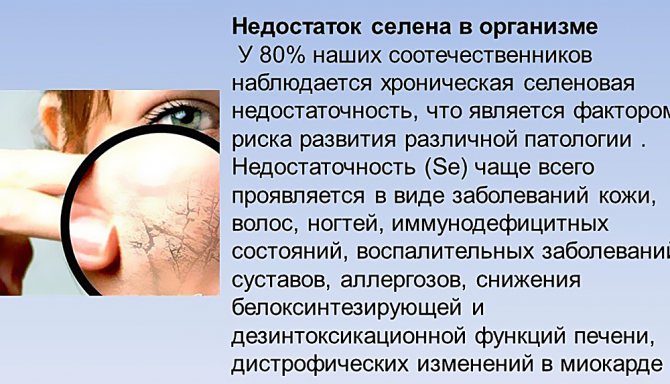
With an abnormally low intake of selenium from water and food into the body over a long period of time, a number of negative phenomena are observed that can occur independently, disguise themselves as other diseases, or aggravate the picture of existing ones. For the convenience of describing such conditions, we will present them in the same sequence in which the physiological effects of this element were described.
As a result of selenium deficiency,:
- Immunity. Its protective properties are significantly weakened. Moreover, all components of the immune system are negatively affected - from leukocytes to antibodies. With prolonged and severe selenium deficiency, states of almost complete immune deficiency can occur. This is manifested by the body's susceptibility to infections of any type. Any infectious diseases are severe, with frequent complications, and are difficult to correct with medication. Recovery from selenium deficiency takes a long time and is rarely complete.
- Antioxidant protection. Selenium deficiency leads to rapid and massive damage to individual cells and rapid wear and tear of tissues and organs. The patient experiences various types of tissue dystrophies, atherosclerotic and other vascular changes. Rapid degeneration of tissues of the central nervous system, bone marrow, muscle fibers. The result of selenium deficiency is various nonspecific diseases, and also, most importantly, aggravation of the course of existing diseases, such as coronary heart disease, bronchial asthma, endocrine pathology and many, many others. This is manifested in more frequent exacerbations, maximum severity of clinical manifestations, more difficult recovery and short duration of remissions.
- Metabolism. Disturbances manifest themselves in aggravation of the course of existing endocrine disorders, as well as excess or, on the contrary, underweight, which cannot be actively corrected with the help of diets. There are often disturbances in water and salt metabolism, the metabolism of other important macro- and microelements, which cascade to even more profound negative changes in the body.
- Normal cell division. This condition is one of the risk factors for the development of tumors, both malignant and benign. If a situation arises where selenium deficiency occurs with tumors already existing in the body, this leads to a sharp increase in the growth and progression of tumors, the occurrence of relapses and the appearance of multiple metastases in malignant tumors.
- Anti-inflammatory function. Inflammatory reactions and processes associated with inflammatory mediators, such as bronchial asthma, allergic reactions of various types, are more pronounced and severe. In this case, they are much less amenable to drug correction.
- Cell protection. The protection of cells from biological toxins, organic and inorganic compounds, especially heavy metal ions, as well as toxic metabolic products of the body itself is sharply reduced, which manifests itself both in a decrease in the overall resistance of the body and in the appearance of a variety of diseases.
- Reproductive function. It is one of the first to suffer, especially among men. This not only in most cases is the cause of male infertility, but also leads to a decrease in the severity of desire and sexual activity. If selenium deficiency develops in women during pregnancy and this deficiency remains uncorrected, this can lead to various pathologies of fetal development. In some cases, a catastrophic lack of selenium causes spontaneous abortions and miscarriage.
Selenium intake standards
As mentioned above, a person does not need much selenium to maintain his health:
- for small children under 3 years old, 20 mcg/day is sufficient;
- up to 8 years - 30 mcg/day;
- up to 14 years - 40 mcg/day;
- children over 14 and adults - 55 mcg/day.
Selenium deficiency can occur in patients with impaired bowel function, as well as in people who eat food grown in selenium-deficient soil. An increased need occurs during pregnancy and breastfeeding - during these periods, women need 60 and 70 mcg/day, respectively. During times of stress or regular physical activity, it is also recommended to increase the selenium dose to at least 70 mcg per day. An even higher dosage is necessary for people with certain diseases: malignant tumors, Alzheimer's, Parkinson's, sclerosis, diseases that impair the functioning of the thyroid gland, and cardiovascular diseases. However, in any of these cases, the daily dosage of selenium should be prescribed by a doctor.
Important! An adult should not exceed a dosage of 400 micrograms per day, including selenium obtained from dietary supplements and food.
The mineral, taken in doses prescribed by a doctor, does not cause side effects. But a significant overdose can cause bad breath, fever, nausea, and in some cases, liver, kidney, and heart problems.
Who may have selenium deficiency in the body?
Today, the risk of selenium deficiency in our body is very unlikely if we eat a healthy and balanced diet, eat food that has grown in soil rich in selenium and do not suffer from stomach and intestinal diseases.
People at risk for selenium deficiency include:
- Elderly people (over 90 years old)
- People with gastrointestinal diseases
- People taking statins (cholesterol-lowering drugs) and birth control and laxative pills
- People who adhere to dietary and vegetarian diets
- Smoking people
- Persons living in regions with low Se content in soils (most regions of Russia)
Selenium-rich foods
- Fish and seafood (tuna, shrimp, salmon, cod, scallops, squid) are very rich in selenium.
- Meat and offal (lamb, beef, chicken, turkey)
- Mushrooms (especially oyster mushrooms and porcini mushrooms)
- Whole grain cereals
But, the leader in selenium content is Brazil nuts!!! Just two Brazil nuts a day can replenish the daily dose of selenium!!!
Daily dose of selenium
The daily intake of selenium is 50-70 mcg per day for adults and 15 to 40 mcg for children.
Dangerous dose of selenium
In large quantities, selenium is poisonous. An excess of selenium in the body is as dangerous as its deficiency.
The upper tolerable intake level for selenium is 400 mcg per day. This is the combined value of selenium intake from food and supplements. This barrier must not be exceeded under any circumstances.
Based on data from the National Institute of Health and Nutrition, it is very difficult to exceed this threshold with our normal diet.
In addition, animal products lose some selenium during heat treatment.
As a practical matter, most of the highest selenium sources contain between 25 and 60 mcg of this mineral.
To exceed the maximum allowable level of selenium, you would have to consume about 5 or even more servings of these selenium-rich foods every day.
